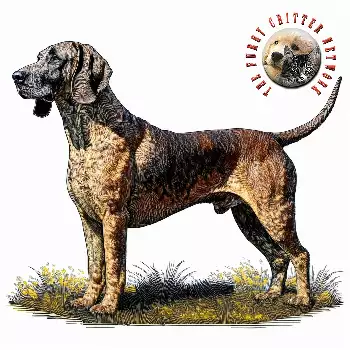Integrating a Hanoverian Scenthound into family life creates unique dynamics that reflect both the breed's working heritage and their deeply loyal nature. These dogs form strong, lasting bonds with their human families while maintaining the independence and thoughtful approach that characterizes their breed. Understanding how they interact within family structures helps ensure successful relationships that benefit both the dogs and their human companions.
The Hanoverian Scenthound typically establishes a hierarchical relationship within the family unit, often forming the strongest bond with the family member who takes primary responsibility for their training, exercise, and daily care. This primary bond doesn't exclude other family members but creates a clear relationship structure that the dog understands and respects. Family members who want to strengthen their relationship with the dog should participate in training activities and provide consistent, positive interactions.
With children, these dogs generally demonstrate remarkable patience and gentleness, though their interactions tend to be more supervisory than playful. They often position themselves where they can observe children's activities, seeming to take a quiet guardianship role. Their substantial size means that interactions with very young children require supervision, not due to aggressive tendencies, but simply to prevent accidental knocking over during normal movement or play.
The breed's response to family routines demonstrates their preference for predictability and structure. Hanoverian Scenthounds adapt well to consistent schedules and often become quite attuned to family patterns, anticipating meal times, walks, and other regular activities. This predictability helps them feel secure and allows them to conserve their mental energy for activities that require their full attention.
In households with multiple pets, Hanoverian Scenthounds often assume a stabilizing role, rarely initiating conflicts but also not tolerating inappropriate behavior from other animals. Their calm, measured approach to inter-pet relationships can help reduce tension in multi-pet households. However, their strong prey drive means that introductions to small pets like cats or rabbits require careful management and supervision.
The breed's exercise and activity needs can be successfully integrated into family life with planning and understanding. While they don't require the intense daily exercise demanded by some working breeds, they do need regular opportunities for meaningful activity that engages their natural abilities. Families who enjoy hiking, nature walks, or outdoor exploration often find that these activities perfectly match their dog's needs while providing quality family time.
Their role in family security is typically subtle but effective. Rather than being aggressive guard dogs, they serve as excellent early warning systems, alerting family members to visitors or unusual activities without creating excessive noise or disturbance. Their discriminating nature allows them to distinguish between normal neighborhood activities and situations that genuinely warrant attention.
Family social activities and gatherings are generally well-tolerated by Hanoverian Scenthounds, though they prefer calmer, more controlled social situations to chaotic parties or large, noisy gatherings. They often choose to observe social activities from a comfortable position nearby rather than actively participating, but their presence adds a calm, stable element to family gatherings.
The breed's relationship with family members of different ages reflects their adaptable nature and inherent gentleness. With elderly family members, they often become devoted companions, seeming to understand the need for quieter activities and gentler interactions. Their calm nature and steady temperament make them excellent therapy dogs for family members who might benefit from their comforting presence.
Training participation within the family context works best when approached as a team effort with clear consistency across all family members. While one person may take the lead in formal training, all family members should understand and reinforce basic commands and household rules. This consistency helps the dog understand their place in the family structure and reduces confusion that can arise from conflicting expectations.
Their adaptation to family travel plans requires some consideration of their preferences and needs. While they can adapt to new environments when traveling with their families, they generally prefer familiar surroundings and routines. For families who travel frequently, establishing consistent routines that can be maintained in different locations helps reduce stress for both the dog and the family.
The breed's interaction with family work schedules demonstrates their adaptability and independence. Unlike breeds that require constant attention and interaction, Hanoverian Scenthounds can handle periods of solitude reasonably well, though they prefer not to be left alone for extremely long periods regularly. They typically adjust well to families with varying work schedules as long as their basic needs for exercise and companionship are met consistently.
Family decision-making regarding the dog's role and activities benefits from understanding the breed's need for purposeful engagement. Families who can provide regular opportunities for scent work, training challenges, or other mentally stimulating activities typically find that their dog is more settled and content in the home environment. This might include organized scent work classes, tracking training, or even simple hide-and-seek games that engage their natural abilities.
The financial aspects of Hanoverian Scenthound ownership should be considered as part of family planning. Their specialized nature may require more expensive training services, and their size means higher costs for food, supplies, and veterinary care. Additionally, families may want to invest in specialized equipment for scent work or tracking activities that can provide appropriate outlets for the dog's natural abilities.
Successful integration of a Hanoverian Scenthound into family life requires all family members to understand and appreciate the breed's working heritage and specialized needs. Families who can provide appropriate mental stimulation, respect the dog's need for purposeful activity, and appreciate their calm, loyal nature typically develop deeply rewarding relationships that enhance the entire family's quality of life. The investment in understanding and accommodating their unique characteristics pays dividends in the form of a devoted, stable, and deeply satisfying canine family member who brings both protection and companionship to the household.

